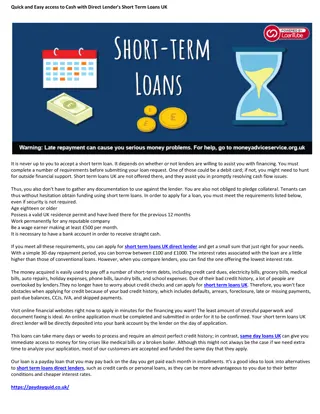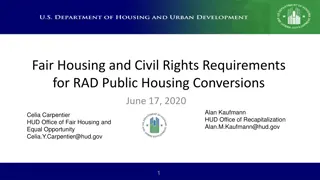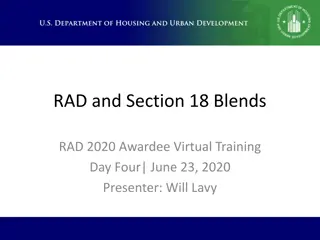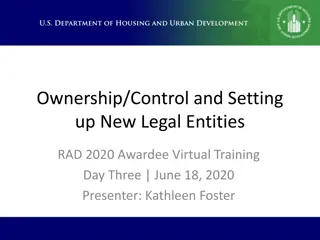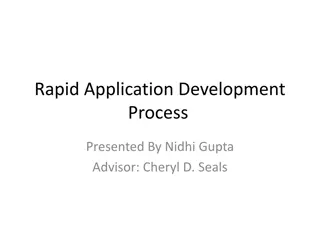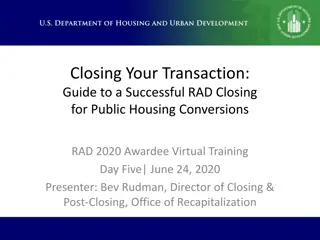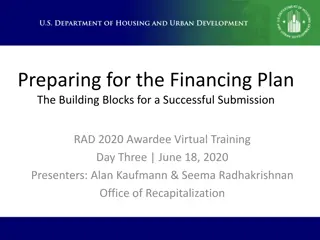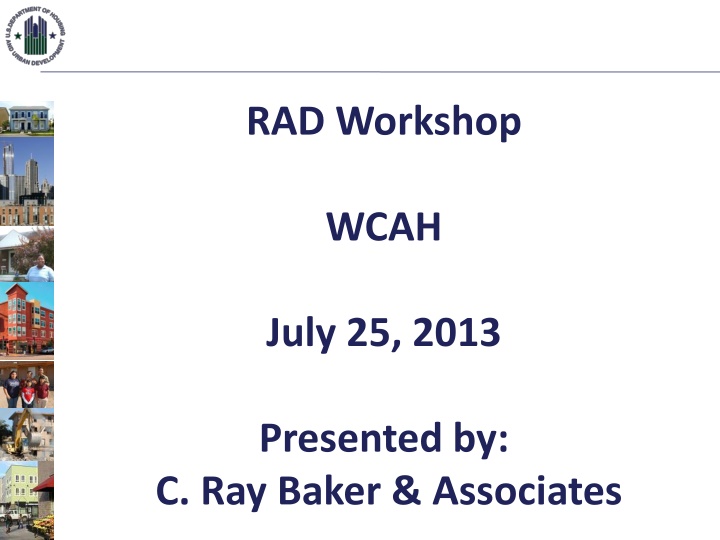
Revitalizing Public Housing through RAD Program: Challenges and Solutions
Discover the RAD program's impact on transforming outdated public housing units into modern homes through innovative funding models, addressing capital repair needs and ensuring sustainability. Learn about the challenges faced by housing authorities and the solutions offered by RAD to improve housing conditions for communities.
Uploaded on | 1 Views
Download Presentation

Please find below an Image/Link to download the presentation.
The content on the website is provided AS IS for your information and personal use only. It may not be sold, licensed, or shared on other websites without obtaining consent from the author. If you encounter any issues during the download, it is possible that the publisher has removed the file from their server.
You are allowed to download the files provided on this website for personal or commercial use, subject to the condition that they are used lawfully. All files are the property of their respective owners.
The content on the website is provided AS IS for your information and personal use only. It may not be sold, licensed, or shared on other websites without obtaining consent from the author.
E N D
Presentation Transcript
RAD Workshop WCAH July 25, 2013 Presented by: C. Ray Baker & Associates
WHY RAD? Most of America s 1.2 million Public Housing units were built as temporary housing beginning in 1937. These units are old, outdated and in desperate need of major capital repairs. RAD will allow PHAs and their developer partners to convert Public Housing units to Section 8 PBV units. During this transformation a combination of LIHTCs and debt will provide the funding necessary to modernize these units. Only a small fraction of the nations 3,200 Housing Authorities have the expertise necessary to implement RAD. 2
CURRENT CHALLENGES Public Housing Capital repair needs in excessof $25.6B across portfolio, or $23,365/unit Section 9 funding platform unreliable (pro-rations, cuts), inhibits access to private debt and equity capital (declaration of trust) Losing 10,000-15,000 hard units/year Section 8 Moderate Rehabilitation (Mod Rehab) Cannot renew on terms needed to secure financing Rent Supplement (Rent Supp) & Rental Assistance Payment (RAP) No option to renew when contracts expire 3
1STCOMPONENT Public Housing & Mod Rehab Can compete to convert assistance to: Project-Based Rental Assistance (PBRA) or Project-Based Vouchers (PBV) Cap of 60,000 units (applications must be received by 9/30/2015) Convert at current funding only Choice-Mobility, with limited exemptions Extensive waiver authority to facilitate conversion 4
2NDCOMPONENT Mod Rehab, Rent Supp & RAP Upon contract termination/expiration, convert Tenant Protection Vouchers (TPVs) to PBVs No cap, but subject to availability of TPVs Choice-Mobility requirement per PBV program rules Limited waiver authority to facilitate conversion Prospectiveconversion authority through 9/30/2013 Retroactive conversion authority back to 10/1/2006 (convert by 9/30/2013) 5
RAD VS. HOPE VI In nine months there are more Public Housing Authorities engaged in RAD than there were in the first two years of the HOPE VI program. There are more Public Housing units in the RAD program than there were in the first two years of the HOPE VI program. The RAD program has not required any additional funding from Congress. 2/2/2012 6
RAD BASICS What? Allows 60,000 public housing units to convert to long-term Section 8 rental assistance contracts Why? Access private debt and equity to finance capital needs Program simplification/streamlining Better platform for long-term preservation Conversion Options Project-Based Rental Assistance (PBRA) Project-Based Vouchers (PBV) 7
RAD WORKSHOP What is RAD? HUD demonstration program that combines public housing operating and capital subsidy into a Section 8 HAP contract What kinds of developments are being done with RAD? Minor rehab; major rehab; new construction; mixed income; off-site replacement housing How do I determine if I have a project/portfolio that would be a good candidate for RAD conversion? Use the RAD Inventory Assessment Tool in the Resources section of www.hud.gov/rad How would RAD affect: Residents: No change; 30% of income for rent PHA Functions: Dependent on cash flow, fees, strong management; puts them on the more secure Section 8 funding platform; Gives them the affordable housing tools of other nonprofit developers Resources: www.hud.gov/rad; www.radcapitalmarketplace.com; www.radresource.net 8
RAD BASICS (CONT.) Ownership Public or non-profit, except to facilitate tax credits Contract Rents Operating Fund (with Operating Fund Allocation Adjustment) + Capital Fund + Tenant Rents = RAD Contract Rent Notes: HUD will honor the FY 2012 RAD contract rents for all applications received before end of CY 2013 (applies to individual applications, portfolio awards, and multi-phase awards) PHA may adjust Contract Rents across multiple projects as long as aggregate subsidy does not exceed current funding ( rent bundling ) 9
PUBLIC HOUSING CONVERSION RENT LEVELS Sample Public Housing Conversion Per Unit Monthly (PUM) $900 $800 $700 Operating Fund $330 Housing Assistance Payment $474 $600 $500 $792 Capital Fund $144 $400 $300 $200 Tenant Tenant Payment $318 Payment $318 $100 $- Pre-Conversion ACC Post-Conversion Section 8 10
NONPROFIT DEVELOPEROBJECTIVES Partner with PHAs to: Modernize aging family & elderly properties Substantial rehab of deteriorated properties Demolish/replace severely distressed/obsolete properties Thin densities/mix incomes via RAD HAPs and transfer authority Place RAD HAP contracts in off-site units in high amenity locations Increase QAP scoring by serving more VLI families New 20 year HAP contract funding 11
RAD FINANCING Debt Conventional Soft secondary Credit enhancement FHA Insurance FHA Mortgagee Letter for RAD transactions LIHTC Pilot LIHTCs 4% availability & considerations 9% availability & considerations 12
FHA MULTIFAMILY MORTGAGE INSURANCE Section 223(f) Refinance or acquisition Minor/moderate repairs ($6,500/unit*high cost factor) Permanent debt with repair escrow - up to 35 years Section 221(d)(4) Substantial rehab: 2 major building systems Construction/permanent debt all in one - initial/final closing 40-year financing Mortgagee Letter for RAD Transactions issued 10/12 Eligibility, underwriting criteria, processing & materials 13
FHA LIHTC PILOT PROGRAM Streamlined-Enhanced FHA 223(f) & LIHTCs Rehab expenditures of up to $40,000/unit Tax credit or Bond Cap allocation in hand Processed in Multifamily Hubs Using MAP lenders approved for the Pilot Goal of 3-4 month turnaround on applications 14
FEDERAL HOME LOAN BANK AHP Affordable Housing Program (AHP) This program is funded with 10% of the Federal Home Loan Banks' net income each year. Most effective when paired with other programs and funding sources, like Low-Income Housing Tax Credits. More than 776,000 housing units have been built using AHP funds, including 475,000 units for very low-income residents. $4.6 billion in total AHP dollars since 1990. That s 200 million per year. AHP loan funding often comes with an equal amount of grant funding. 15
RAD & LIHTCS RAD Sweet Spot Debt Only Abt study $24k/unit average capital need Opex at $4,500 pupy + $300 replacement reserves FHA debt at 3.45%; 1.2 DCR Feasible with RAD rents above ~$610/month 16
RAD & LIHTCS RAD Sweet Spot 4% LIHTCs Rehab needs above $24k/unit to ~$40k/unit Ease of meeting 50% test with RAD rents Available P-A Volume Cap Non-competitive QAPs favoring preservation, green Evolving, accessible short-bond structure Historically low borrowing rates 17
RAD & LIHTCS Short Bond Structure for 4% LIHTCs At Closing TE bonds with 24 month term issued (1.25%) FHA 221(d)(4) or 223(f) closes During Construction Construction draws: Standard GNMA certificates Bonds paid down & paid off at construction completion Reduces negative arbitrage costs Long Term Project benefits from 40-year loan at FHA rate of 3.45% 18
RAD & LIHTCS RAD Sweet Spot 9% LIHTCs Targeted prospects for substantial rehab & replacement housing No Section 18 review Income mixing Split project (AMP) 9% LIHTC used to help cover relo/demo/first phase 4% LIHTC for balance of site RAD HAP contract(s) for off-site replacement Acquisition/rehab New construction 19
RAD ACROSSTHE COUNTRY 1ST COMPONENT Northeast Midwest South West Total PHAs and Mod Rehab Units Awarded 949 1,279 9,997 2,556 14,781 949 Units 1,279 Units 2,556 Units 9,997 Units 20
RAD ACROSS THE COUNTRY 1st Component 132 CHAP awards, representing 14,781 units 51% conversion to PBRA, 49% conversion to PBV Over 60% of proposals planning to use LIHTCs (the vast majority being 4% credits) Over 60 partnering lenders and investors Expected to raise $816M in debt and equity instruments 2nd Component Approved 5,000 units in 48 projects Expecting additional 2,000 unit approvals by end FY 2013 Over 120 projects awaiting approval with additional authority 21
KEY CHANGESINTHE RAD NOTICE Eliminates caps on units that can convert for: Public housing Mode Rehab Creates new awards for: Portfolio conversions PHA defines portfolio of projects, either the entire PHA inventory or some subset PHA must submit applications for at least half of the projects in portfolio HUD will reserve award for remaining units in portfolio PHA must submit application for remaining projects in portfolio within 365 days Multi-phase conversion Allows PHAs to reserve conversion authority for projects with multiple development phases with applicable contract rent for all phases PHA has until July 1, 2015 to submit application for final phase PHA required to fulfill all CHAP milestones for each CHAP awarded Upon application acceptance, HUD will issue CHAP for initial phase and multi-phase award letter covering all phases of project Joint RAD/CNI applicants Opens the Ongoing Mod Rehab Application Period 22
RAD AWARDS TREND CHART 160,000 Aggregated Number of Unit Awards Issued 140,000 Awards-to-Date 120,000 100,000 Awards Expected Based on Application Trends 80,000 Awards Expected Based on Current Outreach 60,000 40,000 Anticipated Future Awards 20,000 0
LENDERSAND TAX CREDIT INVESTORS Alliant Capital Boston Capital California Community Reinvestment Corporation Centerline Capital Group Community Affordable Housing Equity Corporation Community House Partners Development Corporation Direct Tax Credits, Inc. Enterprise Community Investment Georgia Department of Community Affairs Great Lakes Capital Fund Hudson Housing Capital Hunt Capital Parnters National Equity Fund Newport Partners LLC Ohio Capital Corporation Ohio Capital Housing Corporation PNC Real Estate Prestige Affordable Housing Equity Partners Raymond James Tax Credit Funds Inc. RBC Capital Markets Bellwether Enterprise Real Estate Capital LLC Capital Fund Services Inc. Crain Mortgage Group LLC Fifth Third Bank First Citizens Bank NA Forest City Capital Corporation Great Lakes Capital Fund Highland Commercial Mortgage Lake Forest Bank & Trust Company Lancaster Pollard Love Funding M&T PNC Real Estate Prudential Huntoon Paige Associates LLC RBC Capital Markets Housing Finance Group Red Mortgage Capital Rockport Mortgage St. James Capital LLC US Bank Community Development Corporation Walker Dunlop Arbor Commercial Mortgage Beekman Securities Centerline Mortgage Capital Chase Bank Columbus Bank and Trust Continental Mortgage Corporation Federal Home Loan Bank of Chicago Hunt Capital Partners McCan Communities New Mexico Bank & Trust NW Financial Group LLC Rabobank N.A. Red Stone Equity Partners SunTrust Bank TD Bank US Bank Red Stone Equity Partners Richmon Group Union Bank 24
RAD WEB PAGE RAD Notice, application materials, and additional resources can be found at www.hud.gov/rad Email questions to radresource.net 25



